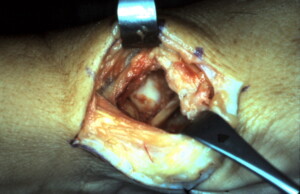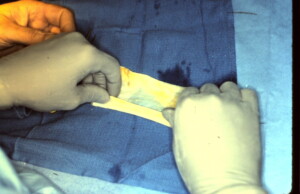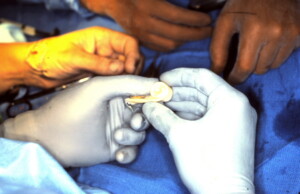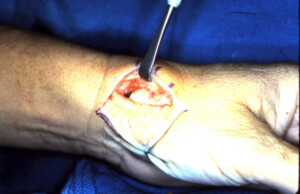Trapezium Arthroplasty for Basal Joint Arthritis
Thumb arthritis (basal joint arthritis) is the most common form of osteoarthritis affecting the hand. Basal joint arthritis occurs when the cushioning cartilage wears away from the adjoining ends of the bones that form your thumb basal joint (carpometacarpal joint). This can cause severe hand pain, swelling, decreased range of motion and decreased strength, making it difficult to do simple household tasks, such as turning doorknobs and opening jars.
Treatment for basal joint arthritis may include avoidance, splints, medication or corticosteroid injections. If you have severe thumb arthritis not controlled by conservative measures you may need surgery. There are many different types of surgery to correct this problem all primarily focus on removing the offending joint (trapeziectomy) and providing a cushion (interposition arthroplasty) to maintain the length of the thumb and eliminate the bone-on-bone pain and restore function.
 A trapeziectomy is performed (the trapezium is removed).
A trapeziectomy is performed (the trapezium is removed).
 Fascia lata allograft is folded on itself the width of the distance from the base of the metacarpal to the scaphoid.
Fascia lata allograft is folded on itself the width of the distance from the base of the metacarpal to the scaphoid.
 The graft is then rolled into an anchovy the approximate size of the removed bone and secured with sutures to maintain its’ shape.
The graft is then rolled into an anchovy the approximate size of the removed bone and secured with sutures to maintain its’ shape.
 The graft is inserted into the defect to maintain length of the thumb axis, prevent collapse and eliminate the rough bone to rough bone contact, thereby eliminating pain and not compromising motion. The capsulo-periosteal flaps are then securely closed.
The graft is inserted into the defect to maintain length of the thumb axis, prevent collapse and eliminate the rough bone to rough bone contact, thereby eliminating pain and not compromising motion. The capsulo-periosteal flaps are then securely closed.



